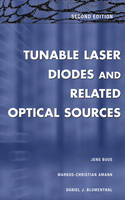Tunable Laser Diodes and Related Optical Sources
 -15%
portes grátis
-15%
portes grátis
Tunable Laser Diodes and Related Optical Sources
Amann, Markus-Christian; Buus, Jens; Blumenthal, Daniel J.
John Wiley & Sons Inc
03/2005
408
Dura
Inglês
9780471208167
15 a 20 dias
772
1 Introduction.
2 Fundamental Laser Diode Characteristics.
2.1 Optical Gain in Semiconductors.
2.2 Semiconductor Heterostructures.
2.2.1 Carrier Confinement.
2.2.2 Optical Confinement.
2.2.3 Material Systems.
2.3 Waveguiding and Transverse Laser Modes.
2.3.1 The Slab Waveguide.
2.3.2 Lateral Waveguiding.
2.4 Laser Structures.
2.5 The Fabry-Perot Laser.
2.6 The Rate Equations.
2.6.1 Stationary Solution of the Rate Equations.
2.6.2 Laser Spectrum and Side-Mode Suppression.
2.6.3 Small-Signal Modulation Behavior.
2.7 Quantum Well Laser Diodes.
3 Single-Mode Laser Diodes.
3.1 Mode Selectivity Requirements.
3.2 Wave Propagation in Periodic Structures.
3.2.1 Alternative Derivation of the Coupled-Mode Equations.
3.2.2 Solution of the Coupled-Mode Equations.
3.3 Distributed Bragg-Reflector Lasers.
3.3.1 Magnitude and Phase of Reflection.
3.3.2 Grating Shapes.
3.3.3 DBR Laser Structures.
3.4 Distributed-Feedback Lasers.
3.4.1 DFB Laser With Nonreflecting Facets.
3.4.2 DFB Lasers With Reflecting Facets.
3.4.3 Phase-Shifted and Gain-Coupled DFB Lasers.
3.5 Laser Fabrication and Tolerances.
3.5.1 Wavelength Dependence on Structural Parameters.
3.5.2 Thermal Properties under CW Operation.
3.6 Spectral Linewidth.
4 Basic Concepts of Tunable Laser Diodes.
4.1 Continuous, Discontinuous, and Quasicontinuous Tuning Schemes.
4.2 Tuning of Cavity Gain Characteristic.
4.3 Tuning of Comb-Mode Spectrum.
4.4 Simultaneous Tuning of Cavity Gain and Comb-Mode Spectrum.
4.5 Electronic Wavelength Control.
4.5.1 The Free-Carrier Plasma Effect.
4.5.2 The Quantum-Confined Stark Effect.
4.5.3 Thermal Tuning.
4.6 Integration Techniques.
4.7 Dynamic Behavior.
5 Wavelength-Tunable Single-Mode Laser Diodes.
5.1 Longitudinally Integrated Structures.
5.1.1 Two-Section DBR Laser.
5.1.2 Three-Section DBR Laser.
5.1.3 Multisection DFB Laser.
5.2 Transversely Integrated Structures.
5.2.1 Tunable Twin-Guide DFB Laser.
5.2.2 Striped Heater DFB Laser.
5.3 Integration Technology.
5.4 Physical Limitations on the Continuous Tuning Range.
5.5 Tuning Dynamics and Modulation.
6 Linewidth Broadening.
6.1 Injection-Recombination Shot Noise in the Tuning Region.
6.2 Impedance and Thermal Noise of Bias Source.
6.3 Spatial Correlation.
6.4 1/f Noise.
6.5 Fluctuations of Bias Source.
7 Widely Tunable Monolithic Laser Diodes.
7.1 The Vernier Effect.
7.2 DBR-type Laser Structures.
7.2.1 Sampled-Grating DBR Lasers.
7.2.2 Superstructure-Grating DBR Lasers.
7.2.3 Digital Supermode DBR Lasers.
7.2.4 Superimposed and Binary Gratings.
7.3 Interferometric Structures.
7.3.1 Lateral Integration: The Y-Laser.
7.3.2 Transverse Integration: The VMZ Laser.
7.4 Codirectionally Coupled Laser Diodes.
7.4.1 Theory for Codirectional Coupling.
7.4.2 Tuning and Mode Spacing.
7.4.3 Longitudinally Integrated Structures.
7.4.4 Transversely Integrated Structures.
7.5 Combination of Techniques.
7.5.1 The Grating-Coupled Sampled-Reflector Laser.
7.5.2 The Modulated-Grating Y-structure Laser.
7.6 Comparison of Widely Tunable Monolithic Laser Structures.
8 Practical Issues Related to Monolithic Tunable Laser Diodes.
8.1 Characterization and Control.
8.1.1 DFB and DBR Lasers.
8.1.2 Widely Tunable Lasers.
8.2 Wavelength Stability and Aging.
8.3 Modulation and Wavelength-Switching Dynamics.
8.3.1 Modulation and Transmission.
8.3.2 Wavelength Switching.
8.4 Monolithic Integration.
9 Related DWDM Sources.
9.1 External-Cavity Lasers.
9.1.1 External Grating and External Filter Cavities.
9.1.2 MEMS External Cavities.
9.1.3 Hybrid Structures.
9.2 Vertical-Cavity Lasers.
9.2.1 VCSEL Basics.
9.2.2 Tunable VCSELs.
9.3 Laser Arrays.
9.3.1 Multistripe Arrays.
9.3.2 Selectable Arrays.
9.3.3 DBR Arrays.
9.3.4 Phased Arrays.
9.4 Technology Summary.
9.5 Fiber and Waveguide Lasers.
9.6 Tunable Pulse Sources and Comb Generators.
10 Communications Applications and Requirements.
10.1 Wavelength Tunability.
10.1.1 Tuning Speed and Latency.
10.1.2 Tuning Continuity.
10.1.3 Tuning Uniformity.
10.1.4 Tuning Stability and Accuracy.
10.1.5 Other Design Considerations.
10.2 Functions and Components.
10.2.1 Tunable Transmitters and Transponders.
10.2.2 Tunable Wavelength Converters with Regeneration Capability.
10.2.3 Optical Wavelength Switches.
10.3 Communications Applications.
10.3.1 Point-to-Point Links and Networks.
10.3.2 Fixed-Wavelength Networks.
10.3.3 Reconfigurable Networks.
10.3.4 Optical-Protection Switching.
10.3.5 Optical-Burst Switching.
10.3.6 Photonic-Packet Switching.
11 Other Applications.
11.1 Optical Frequency-Modulated Continuous-Wave Radar.
11.2 Optical Components Characterization.
11.3 Trace-Gas Sensing, Environmental Analysis, and Spectroscopy.
11.4 Heterodyne Techniques.
11.5 Optical Spectrum and Network Analysis.
11.6 Anemometry.
Appendix A: Refractive Index of InGaAsP.
Appendix B: The Slab Waveguide.
Appendix C: Transfer Matrices.
Appendix D: Thermal Response of a Laser Diode.
D.1 Pulse Response in the Time Domain.
D.2 Response in the Frequency Domain.
Appendix E: Theory for General Reflectors.
Appendix F: Codirectional Coupling.
List of Symbols.
List of Acronyms.
Index.
About the Authors.
1 Introduction.
2 Fundamental Laser Diode Characteristics.
2.1 Optical Gain in Semiconductors.
2.2 Semiconductor Heterostructures.
2.2.1 Carrier Confinement.
2.2.2 Optical Confinement.
2.2.3 Material Systems.
2.3 Waveguiding and Transverse Laser Modes.
2.3.1 The Slab Waveguide.
2.3.2 Lateral Waveguiding.
2.4 Laser Structures.
2.5 The Fabry-Perot Laser.
2.6 The Rate Equations.
2.6.1 Stationary Solution of the Rate Equations.
2.6.2 Laser Spectrum and Side-Mode Suppression.
2.6.3 Small-Signal Modulation Behavior.
2.7 Quantum Well Laser Diodes.
3 Single-Mode Laser Diodes.
3.1 Mode Selectivity Requirements.
3.2 Wave Propagation in Periodic Structures.
3.2.1 Alternative Derivation of the Coupled-Mode Equations.
3.2.2 Solution of the Coupled-Mode Equations.
3.3 Distributed Bragg-Reflector Lasers.
3.3.1 Magnitude and Phase of Reflection.
3.3.2 Grating Shapes.
3.3.3 DBR Laser Structures.
3.4 Distributed-Feedback Lasers.
3.4.1 DFB Laser With Nonreflecting Facets.
3.4.2 DFB Lasers With Reflecting Facets.
3.4.3 Phase-Shifted and Gain-Coupled DFB Lasers.
3.5 Laser Fabrication and Tolerances.
3.5.1 Wavelength Dependence on Structural Parameters.
3.5.2 Thermal Properties under CW Operation.
3.6 Spectral Linewidth.
4 Basic Concepts of Tunable Laser Diodes.
4.1 Continuous, Discontinuous, and Quasicontinuous Tuning Schemes.
4.2 Tuning of Cavity Gain Characteristic.
4.3 Tuning of Comb-Mode Spectrum.
4.4 Simultaneous Tuning of Cavity Gain and Comb-Mode Spectrum.
4.5 Electronic Wavelength Control.
4.5.1 The Free-Carrier Plasma Effect.
4.5.2 The Quantum-Confined Stark Effect.
4.5.3 Thermal Tuning.
4.6 Integration Techniques.
4.7 Dynamic Behavior.
5 Wavelength-Tunable Single-Mode Laser Diodes.
5.1 Longitudinally Integrated Structures.
5.1.1 Two-Section DBR Laser.
5.1.2 Three-Section DBR Laser.
5.1.3 Multisection DFB Laser.
5.2 Transversely Integrated Structures.
5.2.1 Tunable Twin-Guide DFB Laser.
5.2.2 Striped Heater DFB Laser.
5.3 Integration Technology.
5.4 Physical Limitations on the Continuous Tuning Range.
5.5 Tuning Dynamics and Modulation.
6 Linewidth Broadening.
6.1 Injection-Recombination Shot Noise in the Tuning Region.
6.2 Impedance and Thermal Noise of Bias Source.
6.3 Spatial Correlation.
6.4 1/f Noise.
6.5 Fluctuations of Bias Source.
7 Widely Tunable Monolithic Laser Diodes.
7.1 The Vernier Effect.
7.2 DBR-type Laser Structures.
7.2.1 Sampled-Grating DBR Lasers.
7.2.2 Superstructure-Grating DBR Lasers.
7.2.3 Digital Supermode DBR Lasers.
7.2.4 Superimposed and Binary Gratings.
7.3 Interferometric Structures.
7.3.1 Lateral Integration: The Y-Laser.
7.3.2 Transverse Integration: The VMZ Laser.
7.4 Codirectionally Coupled Laser Diodes.
7.4.1 Theory for Codirectional Coupling.
7.4.2 Tuning and Mode Spacing.
7.4.3 Longitudinally Integrated Structures.
7.4.4 Transversely Integrated Structures.
7.5 Combination of Techniques.
7.5.1 The Grating-Coupled Sampled-Reflector Laser.
7.5.2 The Modulated-Grating Y-structure Laser.
7.6 Comparison of Widely Tunable Monolithic Laser Structures.
8 Practical Issues Related to Monolithic Tunable Laser Diodes.
8.1 Characterization and Control.
8.1.1 DFB and DBR Lasers.
8.1.2 Widely Tunable Lasers.
8.2 Wavelength Stability and Aging.
8.3 Modulation and Wavelength-Switching Dynamics.
8.3.1 Modulation and Transmission.
8.3.2 Wavelength Switching.
8.4 Monolithic Integration.
9 Related DWDM Sources.
9.1 External-Cavity Lasers.
9.1.1 External Grating and External Filter Cavities.
9.1.2 MEMS External Cavities.
9.1.3 Hybrid Structures.
9.2 Vertical-Cavity Lasers.
9.2.1 VCSEL Basics.
9.2.2 Tunable VCSELs.
9.3 Laser Arrays.
9.3.1 Multistripe Arrays.
9.3.2 Selectable Arrays.
9.3.3 DBR Arrays.
9.3.4 Phased Arrays.
9.4 Technology Summary.
9.5 Fiber and Waveguide Lasers.
9.6 Tunable Pulse Sources and Comb Generators.
10 Communications Applications and Requirements.
10.1 Wavelength Tunability.
10.1.1 Tuning Speed and Latency.
10.1.2 Tuning Continuity.
10.1.3 Tuning Uniformity.
10.1.4 Tuning Stability and Accuracy.
10.1.5 Other Design Considerations.
10.2 Functions and Components.
10.2.1 Tunable Transmitters and Transponders.
10.2.2 Tunable Wavelength Converters with Regeneration Capability.
10.2.3 Optical Wavelength Switches.
10.3 Communications Applications.
10.3.1 Point-to-Point Links and Networks.
10.3.2 Fixed-Wavelength Networks.
10.3.3 Reconfigurable Networks.
10.3.4 Optical-Protection Switching.
10.3.5 Optical-Burst Switching.
10.3.6 Photonic-Packet Switching.
11 Other Applications.
11.1 Optical Frequency-Modulated Continuous-Wave Radar.
11.2 Optical Components Characterization.
11.3 Trace-Gas Sensing, Environmental Analysis, and Spectroscopy.
11.4 Heterodyne Techniques.
11.5 Optical Spectrum and Network Analysis.
11.6 Anemometry.
Appendix A: Refractive Index of InGaAsP.
Appendix B: The Slab Waveguide.
Appendix C: Transfer Matrices.
Appendix D: Thermal Response of a Laser Diode.
D.1 Pulse Response in the Time Domain.
D.2 Response in the Frequency Domain.
Appendix E: Theory for General Reflectors.
Appendix F: Codirectional Coupling.
List of Symbols.
List of Acronyms.
Index.
About the Authors.















